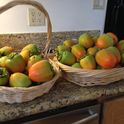I have 20 lbs of Hachiya Persimmons ripening. What can I do with all of this fruit?
15 Comments
ManishaDecember 14, 2023
Has anyone used the skin of persimmons (non astringent soft and squishy variety) in making jam?
Kathryn H.September 21, 2014
James Beards Persimmon Bread - http://www.davidlebovitz...
Make a persimmon paste and use in place of quince paste on a cheese board- http://www.taste.com.au/recipes/12630/persimmon+paste
Chocolate & Persimmon tart - http://www.greenkitchenstories.com/persimmon-tart-a-la-golubka/
Make a persimmon paste and use in place of quince paste on a cheese board- http://www.taste.com.au/recipes/12630/persimmon+paste
Chocolate & Persimmon tart - http://www.greenkitchenstories.com/persimmon-tart-a-la-golubka/
taniabrSeptember 17, 2014
Hello @CLK
I agree with everyone, the instant persimmon sorbet is a great idea - https://food52.com/recipes...
I also tried persimmon bruschetta once and I loved it -
https://food52.com/recipes...
These are the easy peasy recipes but as you've got many persimmons, you could go fancy with James Beard's persimmon bread -
http://www.davidlebovitz...
or Golubka chocolate persimmon tart for Green Kitchen Stories -
http://www.greenkitchenstories.com/persimmon-tart-a-la-golubka/
Enjoy !
I agree with everyone, the instant persimmon sorbet is a great idea - https://food52.com/recipes...
I also tried persimmon bruschetta once and I loved it -
https://food52.com/recipes...
These are the easy peasy recipes but as you've got many persimmons, you could go fancy with James Beard's persimmon bread -
http://www.davidlebovitz...
or Golubka chocolate persimmon tart for Green Kitchen Stories -
http://www.greenkitchenstories.com/persimmon-tart-a-la-golubka/
Enjoy !
Shuna L.September 17, 2014
There's no such thing as too many persimmons. They are incredibly high in pectin so can set just about anything - including stopping one's blender mid-whir - so be careful. A frozen soft persimmon *is* sorbet. I agree with all the steamed pudding people - but - let's be honest - they taste nothing like a persimmon. Persimmon is merely a vehicle for tenderness. Which gets me thinking... persimmon might be a good egg replacer like flax or banana puree or apple sauce... When persimmons are in season, rejoice.
Diana B.September 13, 2014
Here are a couple, along with their sources; the notes talk about Hachiyas, but the recipes don't specify which type of persimmon to use. I've used Fuyu pulp for both recipes and it works just fine.
Persimmon Jam
http://www.persimmonpudding.com/recipes/other/persimmonjam.html
2 Quarts ripe fresh persimmon pulp
1 Cup sugar
1 Cup orange juice
grated rind of 1 orange
Combine all ingredients in a 4-quart enameled or stainless steel pan and cook over medium-high heat, stirring often until thickened, usually about 20 minutes.
Pour into sterilized half-pint jars and seal at once. This recipe makes 6 half-pint jars.
– or –
http://recipes.epicurean.com/recipe/3488/persimmon-jam.html
3 cups Persimmon pulp*
2 cups sugar
1 tablespoon fresh lemon juice
½ teaspoon grated lemon zest
Make Persimmon Pulp, using 3 to 4 persimmons.
Combine 3 cups persimmon pulp and the sugar in heavy medium noncorrosive saucepan. Cook over low heat, stirring constantly, until thickened and opaque, about 15 minutes; do not boil. Remove from heat. Stir in lemon juice and zest. Pour into sterilized canning jars and seal according to manufacturer's directions.
*Persimmon pulp: One Japanese (Hachiya) persimmon yields 3/4 to 1 cup pulp. Rinse persimmon briefly under cold running water; pat dry. Make x-shaped cut in pointed end with small sharp knife. Peel back sections of the skin from cut end; discard any seeds. Discard skin and stem end. Use or freeze pulp as is, or process in food processor fitted with metal blade or in a blender until smooth.
*Tip: To prevent discoloration of pulp, remove pulp from persimmon just before using. When freezing pulp, preferable in 1- or 2- cup portions, add a small pinch of ascorbic acid or a few drops of lemon juice to pulp to prevent discoloration.
Persimmon Jam
http://www.persimmonpudding.com/recipes/other/persimmonjam.html
2 Quarts ripe fresh persimmon pulp
1 Cup sugar
1 Cup orange juice
grated rind of 1 orange
Combine all ingredients in a 4-quart enameled or stainless steel pan and cook over medium-high heat, stirring often until thickened, usually about 20 minutes.
Pour into sterilized half-pint jars and seal at once. This recipe makes 6 half-pint jars.
– or –
http://recipes.epicurean.com/recipe/3488/persimmon-jam.html
3 cups Persimmon pulp*
2 cups sugar
1 tablespoon fresh lemon juice
½ teaspoon grated lemon zest
Make Persimmon Pulp, using 3 to 4 persimmons.
Combine 3 cups persimmon pulp and the sugar in heavy medium noncorrosive saucepan. Cook over low heat, stirring constantly, until thickened and opaque, about 15 minutes; do not boil. Remove from heat. Stir in lemon juice and zest. Pour into sterilized canning jars and seal according to manufacturer's directions.
*Persimmon pulp: One Japanese (Hachiya) persimmon yields 3/4 to 1 cup pulp. Rinse persimmon briefly under cold running water; pat dry. Make x-shaped cut in pointed end with small sharp knife. Peel back sections of the skin from cut end; discard any seeds. Discard skin and stem end. Use or freeze pulp as is, or process in food processor fitted with metal blade or in a blender until smooth.
*Tip: To prevent discoloration of pulp, remove pulp from persimmon just before using. When freezing pulp, preferable in 1- or 2- cup portions, add a small pinch of ascorbic acid or a few drops of lemon juice to pulp to prevent discoloration.
Diana B.September 13, 2014
Did someone say Persimmon Jam? Yes, there certainly is such a thing and you have but to ask for me to insert on right here!
Jan W.September 13, 2014
Hachiya are the *best* persimmons for preserves and canning. However, if you want to be true to tradition, American persimmons (Diospyros virginiana) are the best for bread and steamed pudding, because they have a bit more of a characteristic tang (yet still sweet and no cottonmouth when ripe) that adds to the flavor.
You could also make a fantastic sorbet with them, or you could do as the Japanese have done for centuries and dry them to make a delicious chewy fruit snack.
You could also make a fantastic sorbet with them, or you could do as the Japanese have done for centuries and dry them to make a delicious chewy fruit snack.
passifloraedulisSeptember 13, 2014
Mine this contest for inspiration! https://food52.com/contests...
Susan W.September 12, 2014
Is there such a thing as persimmon jam?If so..yum!!
HalfPintSeptember 12, 2014
You can freeze them for later & make persimmon bread, smoothies, and steamed pudding.
HalfPintSeptember 13, 2014
No, you can freeze the fruit whole, but pureeing and put the pulp into plastic freezer bags ( like Ziplocs) would maximize your freezer space.
songyaDecember 3, 2018
Great to know about the high pectin content! So, that explains the success of low-sugar jams in this blog. I have about 15 fuyu persimmons, (not as good as Hachiya or the native east American--but still yummy), and have enough to freeze. Might be good with berries, plums, etc? Turns out that bruised fruit, though it turns darker, keeps a good flavor, as do apricots. Could it be due to the particular antioxidants in these deep orange (when ripe!) fruits? In breads & steamed pudding, flavor IS different--but also delicious!
Showing 15 out of 15 Comments
Recommended by Food52
Popular on Food52
Continue After Advertisement






